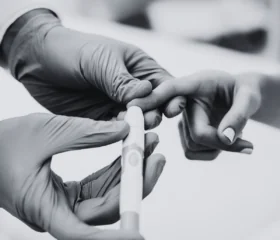Eleven Lifestyle Habits for Lowering Blood Pressure

What’s the relationship between diabetes and high blood pressure (hypertension is the medical term)? Let’s look at some facts and highlight many ways you can manage blood pressure and diabetes with some simple lifestyle adjustments!
Fact: Hypertension is twice as likely to affect a person with diabetes than someone without diabetes.1
Fact: If you have diabetes and hypertension and both are undiagnosed or untreated, you are four times more likely to develop heart disease than someone who does not have either condition.2
Fact: Your risk of a stroke is tripled if you have both diabetes and hypertension.3
Fact: You are 2.5 times more likely to get type 2 diabetes if you have hypertension.4
Fortunately, a healthy lifestyle can help you better manage your blood pressure and may prevent, delay or reduce your need for medication. That’s a win-win for reducing your healthcare expenses, spending less time in doctor’s offices, and feeling better! Here are 11 effective lifestyle habits that lower your blood pressure without medication to reduce your risk of heart disease and strokes.5
- Lose excess weight: Aim for a waist size of less than half your height (in inches or centimeters). Forget “dieting” because that’s never a long-term solution. If you need help, talk with your doctor and a nutritionist.
- Stay active: If your job requires you to sit a lot, set an automatic timer and get up every half hour. Take a brisk walk up some stairs, or do squats at your desk with a hand-held dumbbell weight. A series of one to two-minute bursts of activity are better for your health than one long exercise session followed by long periods of sitting!
- Eat healthy food: Mom was right; eat lots of leafy and low-carb vegetables- as much as you want- every day! Small amounts of nuts, seeds, fruit, and whole grains, plus a good portion of any legume (cooked dried beans, lentils, chickpeas, etc.), will help you feel full longer and aid in lowering your weight. Eat small portions of all animal proteins since they contain cholesterol, saturated fat, zero fiber, and are high in calories. Eating processed meats and other highly processed foods that contain added nitrites and nitrates is directly linked to a higher risk of developing type 2 diabetes, breast, ovarian, brain, and other cancers.6 & 7 Be smart, and eat real, tasty, unprocessed foods!
- Consume less salt: Did you know that bread and tomato sauce are high in sodium and can push your blood pressure up? Read food labels and keep your sodium intake below 1,500 mg a day. Natural, unprocessed foods are all very low in sodium. Use herbs and spices instead of salt to add flavor to your food.
- Limit alcohol to less than one drink a day: One drink is 12 ounces of beer, 5 ounces of wine, or 1.5 ounces of 80-proof liquor. Drink alcohol just on special occasions, or skip it entirely.
- If you smoke, quit: Smoking increases blood pressure and the risk of heart disease, gum disease, and lung cancer. It’s also expensive.
- Get enough sleep: If you have trouble sleeping, talk with your doctor about finding and treating the cause, not the symptoms, to help improve your sleep.
- Reduce stress: Everyone has stress but you can choose how you react to it. Yoga, meditation, deep breathing, going for a walk, listening to relaxing music, and other simple, free activities can help you control stress so that it doesn’t spike your blood pressure.
- Keep tabs on your blood pressure: Monitor and record your blood pressure at home and get regular checkups. Aim for your blood pressure to be 129/79 or lower by living a healthy, satisfying lifestyle.
- Strive to meet your diabetes goals: Work with your healthcare team on a plan to meet your blood sugar and A1C goals as often as possible.
- Get support: Managing your blood pressure and life’s other challenges is much easier when you have encouragement and support from your family and friends! If you need more help, join a support group where you can meet face-to-face or online for free. They can provide valuable tips and emotional and moral support to help you manage your blood pressure and diabetes better.
References and Resources
Image by from Pixabay
1https://www.hopkinsmedicine.org/health/conditions-and-diseases/diabetes/diabetes-and-high-blood-pressure
2https://www.hopkinsmedicine.org/health/conditions-and-diseases/diabetes/diabetes-and-high-blood-pressure
3https://www.nejm.org/doi/full/10.1056/neJm200003303421301
4https://www.ahajournals.org/doi/10.1161/01.STR.0000190894.30964.75
5https://www.mayoclinic.org/diseases-conditions/high-blood-pressure/in-depth/high-blood-pressure/art-20046974
Tom Lang has worked as a research assistant at the pharmaceutical giant Hoechst in Germany and at The Albert Einstein College of Medicine in New York. Trained as a biologist, he lives on the west coast with his wife, Cate, and their rescued dog, Te amo. Tom has coached over 1,000 women and men with prediabetes and diabetes and has helped two family members with diabetes.
Written by





